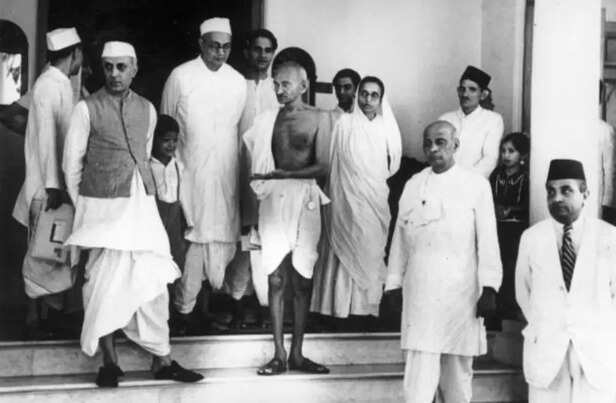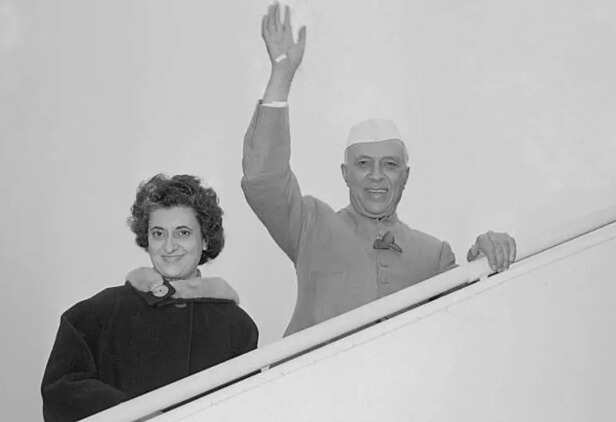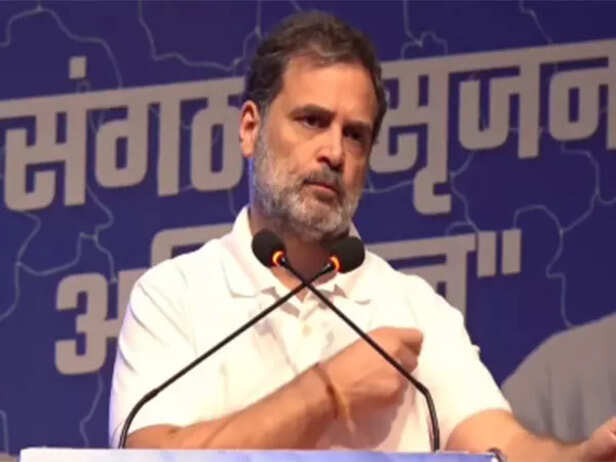How Congress Manipulated Indian Democracy and History
Ankit Gupta | Jun 12, 2025, 23:59 IST
Congress, having rigged early elections, hijacked internal democracy, suspended fundamental rights during Emergency, and manipulated historical education, stands morally discredited to lecture others on democratic values. While every government must be held accountable — including the BJP — it is crucial to remember who set the precedent. India’s democracy did not grow because of Congress; it survived despite it.
When we speak of Indian democracy, we often repeat the official narrative — that it was carefully built, nurtured, and protected by the Congress Party, especially the Nehru-Gandhi dynasty. For decades, this story was passed down through textbooks, government commemorations, and national memory. But beneath the surface of this glorified tale lies a history of calculated moves, suppressions, and manipulations. From the time before India’s independence to modern-day politics, the Congress has not only rigged democratic processes but also rewritten history to suit its political interests.
Contrary to its claims, Congress did not build Indian democracy. It rigged it — sometimes overtly, sometimes subtly — sidelining national icons, suppressing dissent, and altering historical facts to keep its dominance unchallenged.

The manipulation began even before India achieved independence. The year was 1946, and the Congress Party was internally deciding who would be its president — a position that, under the British plan for independence, would also effectively become the first Prime Minister of India. Out of the 15 Pradesh Congress Committees (PCCs), 12 nominated Sardar Vallabhbhai Patel, the Iron Man of India. Patel was respected, grounded, and admired by the party rank and file for his organizational prowess and administrative acumen.
However, Jawaharlal Nehru, despite receiving no nominations, was not ready to step aside. It was then that Mahatma Gandhi intervened, reportedly asking Patel to withdraw in favor of Nehru — which he did, out of loyalty and discipline. But the damage was done. The first true election within the party was thwarted not by voters, but by court politics, personal favoritism, and ideological preferences.
Thus, India’s first Prime Minister wasn’t democratically selected, but installed through internal manipulation. This set a dangerous precedent: loyalty to lineage and ideology took precedence over democratic selection — a pattern that would repeat itself across generations.
India's first general elections in 1952 were hailed as a democratic triumph. But hidden beneath that milestone were two highly controversial episodes that revealed Congress’s determination to shape outcomes through manipulation.
In Rampur, Vishan Chandra Seth, a popular independent candidate, defeated Congress stalwart Maulana Abul Kalam Azad by over 1,000 votes. However, post-poll scrutiny reversed the result under suspicious circumstances, and Azad was declared the winner. To this day, historians argue that the Congress high command could not afford to let a top leader lose in the very first election, and hence, the result was overturned without proper explanation. The media at the time raised concerns, but the Congress-controlled environment suppressed the outrage.
Another troubling episode was the defeat of Dr. B.R. Ambedkar — the chief architect of the Indian Constitution. He contested from Bombay North and lost. While defeats are part of politics, what raised alarms was that over 78,000 votes were suddenly declared invalid. These were primarily from Dalit and working-class bastis that supported Ambedkar. Many believe this was a deliberate act to eliminate Ambedkar’s legislative presence, especially because his criticism of Congress policies and caste politics was becoming increasingly sharp.
Ambedkar, marginalized and disappointed, never returned to Lok Sabha. This was not a loss — this was an engineered political assassination of the very man who gave India its democratic foundation.

In 1971, Indira Gandhi achieved a sweeping electoral victory following her “Garibi Hatao” slogan. However, her own election from Rae Bareli was later challenged by Raj Narain. The Allahabad High Court in 1975 found Indira guilty of electoral malpractices, including misuse of government machinery and exceeding campaign limits. The verdict invalidated her election and barred her from office for six years.
What followed shocked the nation. Instead of stepping down, Indira Gandhi declared a national Emergency — suspending the Constitution, arresting opposition leaders, and censoring the press. For 21 months, democracy was effectively dead. Parliament became a rubber stamp. Courts were tamed. Citizens lost basic rights.
This was not governance, but authoritarian rule — born not out of national crisis, but a personal fear of losing power. Congress’s claim to having nurtured Indian democracy died the day it strangled it with its own hands.
The 1987 Assembly elections in Jammu & Kashmir were meant to be a landmark moment — the region’s first multi-party contest in decades. However, what unfolded was perhaps one of the most destructive electoral riggings in modern Indian history. The Congress-National Conference alliance ensured that the opposition Muslim United Front (MUF) was denied fair representation. Ballot boxes were tampered with, opposition agents beaten, and results changed.
Young Kashmiris who had believed in democracy saw their faith shattered. Many joined militant groups soon after, including key members of the now-infamous Hizbul Mujahideen. Scholars widely agree that the 1987 election pushed Kashmir into an insurgency, from which the region has still not recovered.
What was lost was not just a democratic opportunity, but a generation’s trust in India — all because of Congress’s desperate hold over power, even at the cost of national security.

Over the years, the Congress party has systematically destroyed any semblance of inner-party democracy. From Nehru to Indira, Rajiv to Sonia, and now Rahul Gandhi — the baton of leadership has remained within one family, regardless of performance.
Under Rahul Gandhi, the Congress party has suffered its worst defeats in history:
Democracy cannot survive in a nation where the leading opposition party does not practice what it preaches. Congress has become a dynasty — not a democracy.
If rigging elections was one part of the Congress's playbook, rewriting history was the other.
For decades, Indian textbooks were drafted and curated by Congress-appointed bodies. These books systematically glorified certain figures and erased others who didn’t fit the Nehruvian worldview.
Textbooks became tools to sanctify Nehru, ignoring his blunders — such as:

In recent years, the current BJP government has been accused of rewriting history from a Hindu nationalist lens. References to Mahatma Gandhi’s opposition to Hindu nationalism, or events like the 2002 Gujarat riots, have been allegedly removed or edited.
Critics claim this is a political agenda. Supporters argue that it is corrective history, finally giving voice to neglected icons like Savarkar, Rani Durgavati, Lachit Borphukan, and Ahilyabai Holkar, while acknowledging Islamic invasions, temple destruction, and resistance movements that Congress-era books ignored.
The truth lies somewhere in between. All governments, it seems, struggle to resist the temptation of sculpting history in their own image.
But before pointing fingers, the Congress must ask itself: Who began this distortion in the first place?
Today, the Congress Party claims to be the guardian of secularism, democracy, and liberal values. But history records something far more cynical:
India is often hailed as the world’s largest democracy. But that democracy was not gifted by the Congress — it survived in spite of it. It survived Patel’s betrayal, Ambedkar’s defeat, Indira’s Emergency, and Rahul’s apathy. It survived rigged elections, biased textbooks, and dynastic arrogance.
If India continues to function as a democracy today, the credit lies with its people, its press, its Supreme Court, and its independent institutions — not with any one party, and certainly not with a party that has repeatedly chosen power over principle.
As India moves forward, a new generation is asking tough questions. Not just of those in power today, but of those who abused power in the past. And in that reckoning, Congress must answer not only for its failures — but for its fabrications.
Contrary to its claims, Congress did not build Indian democracy. It rigged it — sometimes overtly, sometimes subtly — sidelining national icons, suppressing dissent, and altering historical facts to keep its dominance unchallenged.
The 1946 Leadership Rigging

Nehru vs. Patel
( Image credit : Getty Editorial )
The manipulation began even before India achieved independence. The year was 1946, and the Congress Party was internally deciding who would be its president — a position that, under the British plan for independence, would also effectively become the first Prime Minister of India. Out of the 15 Pradesh Congress Committees (PCCs), 12 nominated Sardar Vallabhbhai Patel, the Iron Man of India. Patel was respected, grounded, and admired by the party rank and file for his organizational prowess and administrative acumen.
However, Jawaharlal Nehru, despite receiving no nominations, was not ready to step aside. It was then that Mahatma Gandhi intervened, reportedly asking Patel to withdraw in favor of Nehru — which he did, out of loyalty and discipline. But the damage was done. The first true election within the party was thwarted not by voters, but by court politics, personal favoritism, and ideological preferences.
Thus, India’s first Prime Minister wasn’t democratically selected, but installed through internal manipulation. This set a dangerous precedent: loyalty to lineage and ideology took precedence over democratic selection — a pattern that would repeat itself across generations.
1952: India’s First General Elections – A Trial in Tampering
The Rampur Incident
Ambedkar’s Mysterious Defeat
Ambedkar, marginalized and disappointed, never returned to Lok Sabha. This was not a loss — this was an engineered political assassination of the very man who gave India its democratic foundation.
Indira Gandhi and the 1971 Rigged Election

Nehru and Indira Gandhi
( Image credit : Getty Editorial )
In 1971, Indira Gandhi achieved a sweeping electoral victory following her “Garibi Hatao” slogan. However, her own election from Rae Bareli was later challenged by Raj Narain. The Allahabad High Court in 1975 found Indira guilty of electoral malpractices, including misuse of government machinery and exceeding campaign limits. The verdict invalidated her election and barred her from office for six years.
What followed shocked the nation. Instead of stepping down, Indira Gandhi declared a national Emergency — suspending the Constitution, arresting opposition leaders, and censoring the press. For 21 months, democracy was effectively dead. Parliament became a rubber stamp. Courts were tamed. Citizens lost basic rights.
This was not governance, but authoritarian rule — born not out of national crisis, but a personal fear of losing power. Congress’s claim to having nurtured Indian democracy died the day it strangled it with its own hands.
1987: Kashmir Rigging that Led to Insurgency
Young Kashmiris who had believed in democracy saw their faith shattered. Many joined militant groups soon after, including key members of the now-infamous Hizbul Mujahideen. Scholars widely agree that the 1987 election pushed Kashmir into an insurgency, from which the region has still not recovered.
What was lost was not just a democratic opportunity, but a generation’s trust in India — all because of Congress’s desperate hold over power, even at the cost of national security.
Rahul Gandhi and the Collapse of Internal Democracy

Rahul Gandhi
( Image credit : ANI )
Over the years, the Congress party has systematically destroyed any semblance of inner-party democracy. From Nehru to Indira, Rajiv to Sonia, and now Rahul Gandhi — the baton of leadership has remained within one family, regardless of performance.
Under Rahul Gandhi, the Congress party has suffered its worst defeats in history:
- Lost the 2014 and 2019 General Elections by historic margins.
- Lost more than 88 state elections in a decade.
- Failed to retain traditional strongholds like Amethi and Punjab.
Democracy cannot survive in a nation where the leading opposition party does not practice what it preaches. Congress has become a dynasty — not a democracy.
Manipulating Indian History – Congress’s Quiet Coup in Classrooms
For decades, Indian textbooks were drafted and curated by Congress-appointed bodies. These books systematically glorified certain figures and erased others who didn’t fit the Nehruvian worldview.
Sidelining Patel, Bose, and Ambedkar
- Sardar Patel, India’s first Deputy Prime Minister and the man who united 562 princely states, was reduced to a passing mention in history books.
- Subhas Chandra Bose, who built an army (INA) to liberate India, was portrayed ambiguously and often undermined.
- Ambedkar’s radical critique of the Congress and Gandhi was never taught. His conversion to Buddhism and his warnings against majoritarianism were buried.
The Nehruvian Monopoly
- Mishandling of Kashmir and taking the matter to the UN.
- Poor leadership during the 1962 war with China.
- Delay in implementing Hindu Code reforms due to political pressures.
The BJP Textbook Controversy – A Reaction or Repetition?

Revisions to NCERT textbooks under India's BJP-led government have sparked controversy, with accusations of ideological influence
( Image credit : Pixabay )
In recent years, the current BJP government has been accused of rewriting history from a Hindu nationalist lens. References to Mahatma Gandhi’s opposition to Hindu nationalism, or events like the 2002 Gujarat riots, have been allegedly removed or edited.
Critics claim this is a political agenda. Supporters argue that it is corrective history, finally giving voice to neglected icons like Savarkar, Rani Durgavati, Lachit Borphukan, and Ahilyabai Holkar, while acknowledging Islamic invasions, temple destruction, and resistance movements that Congress-era books ignored.
The truth lies somewhere in between. All governments, it seems, struggle to resist the temptation of sculpting history in their own image.
But before pointing fingers, the Congress must ask itself: Who began this distortion in the first place?
The Congress’s Moral Authority is Broken
- A party that rigged the first leadership election in independent India.
- A party that overturned unfavorable results in 1952.
- A party that declared Emergency to protect a disqualified Prime Minister.
- A party that sparked insurgency through vote fraud in Kashmir.
- A party that silenced internal dissent to preserve dynastic control.
- A party that rewrote history, glorifying its leaders while erasing critics.
A Democracy That Survived Despite Congress
If India continues to function as a democracy today, the credit lies with its people, its press, its Supreme Court, and its independent institutions — not with any one party, and certainly not with a party that has repeatedly chosen power over principle.
As India moves forward, a new generation is asking tough questions. Not just of those in power today, but of those who abused power in the past. And in that reckoning, Congress must answer not only for its failures — but for its fabrications.
